In situ optical and biogeochemical in- and above-water measurements are critical for calibration and validation of satellite ocean colour radiometry data products, and for refinement of ocean colour algorithms. During the SeaWiFS era, NASA commissioned the development of a series of ocean optical measurement protocols (see NASA Ocean Optics Protocols for Satellite Ocean Color Sensor Validation) which have served as international reference standards ever since, and have promoted the collection and assembly of climate quality, ocean optical datasets by the global ocean colour community. Since publication of the last revision in 2004, there have been major advances in instrumentation and observing capability, so these community-vetted protocols are being revised to account for new, emerging, and planned capabilities and modes of deployment.
Over the past few years NASA has sponsored several international workshops with experts (including breakout workshops at the International Ocean Colour Science meetings), to update and develop new community consensus protocols for ocean colour sensor validation. The newly drafted protocols will be made available to the international user community on this webpage for a period of time for testing, public comment and review, before they are accepted as international reference standards. Once accepted, the protocols will receive a publication date and version number (e.g., v1.0), and will also have a digital object identifier (doi) provided by OceanBestPractices. These revised protocols will be revisited periodically to determine if enough changes have taken place to warrant a significant update, in which case a new version number will be assigned.
Ask questions and discuss the published protocols on the IOCCG Github repository for each protocol. Links to each protocol discussion are below.
IOCCG Ocean Optics & Biogeochemistry Protocols for Satellite Ocean Colour Sensor Validation
Correct citation for this volume:
IOCCG Protocol Series (2018). Inherent Optical Property Measurements and Protocols: Absorption Coefficient, Neeley, A. R. and Mannino, A. (eds.), IOCCG Ocean Optics and Biogeochemistry Protocols for Satellite Ocean Colour Sensor Validation, Volume 1.0, IOCCG, Dartmouth, NS, Canada. http://dx.doi.org/10.25607/OBP-119
Download file: Inherent Optical Property Measurements and Protocols: Absorption Coefficient (November 2018)
Abstract
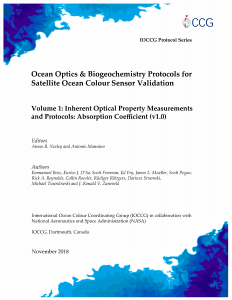 Inherent Optical Properties Measurements and Protocols: Absorption Coefficient is a document that serves as a comprehensive overview of calibration, measurement and analysis protocols for the state-of-the-art technologies that measure the absorption of particles in the water or on a filter pad. Chapter 1 provides a detailed overview of the absorption coefficient of pure water, colored dissolved matter and particles along with the current state-of-the-art pure water absorption coefficients, uncertainties and temperature and salinity corrections. Chapters 2–4 provide detailed protocols for measuring particles in suspension using the reflective tube absorption meter, the integrating cavity absorption meter, and the point-source integrating cavity absorption meter. Lastly, Chapter 5 describes the most up-to-date methods for the measurement of absorbance and the computation of absorption for particles on a filter pad using the transmittance method, transmittance method with fiber optics, the transmittance-reflectance method and inside an integrating sphere. Chapters 1, 2, and 5 represent updated versions of those found in Ocean Optics Protocols for Satellite Ocean Color Sensor Validation Revision 4, Volume IV (Mitchell et al. 2002). Chapters 3 and 4 are new contributions to the protocol.
Inherent Optical Properties Measurements and Protocols: Absorption Coefficient is a document that serves as a comprehensive overview of calibration, measurement and analysis protocols for the state-of-the-art technologies that measure the absorption of particles in the water or on a filter pad. Chapter 1 provides a detailed overview of the absorption coefficient of pure water, colored dissolved matter and particles along with the current state-of-the-art pure water absorption coefficients, uncertainties and temperature and salinity corrections. Chapters 2–4 provide detailed protocols for measuring particles in suspension using the reflective tube absorption meter, the integrating cavity absorption meter, and the point-source integrating cavity absorption meter. Lastly, Chapter 5 describes the most up-to-date methods for the measurement of absorbance and the computation of absorption for particles on a filter pad using the transmittance method, transmittance method with fiber optics, the transmittance-reflectance method and inside an integrating sphere. Chapters 1, 2, and 5 represent updated versions of those found in Ocean Optics Protocols for Satellite Ocean Color Sensor Validation Revision 4, Volume IV (Mitchell et al. 2002). Chapters 3 and 4 are new contributions to the protocol.
Correct citation for this volume:
IOCCG Protocol Series (2019). Beam Transmission and Attenuation Coefficients: Instruments, Characterization, Field Measurements and Data Analysis Protocols. Boss, E., Twardowski, M., McKee, D., Cetinić, I. and Slade, W. IOCCG Ocean Optics and Biogeochemistry Protocols for Satellite Ocean Colour Sensor Validation, Volume 2.0, edited by A. Neeley and I. Cetinić, IOCCG, Dartmouth, NS, Canada. http://dx.doi.org/10.25607/OBP-458
Download File: Beam Transmission and Attenuation Coefficients: Instruments, Characterization, Field Measurements and Data Analysis Protocols.
Abstract
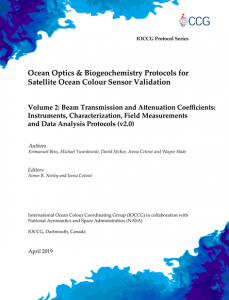 Inherent Optical Properties Measurements and Protocols: Beam Transmission and Attenuation is a document that serves as a comprehensive overview of beam transmittance concepts and the calibration, measurement and analysis protocols for the state-of-the-art technologies that measure the attenuation of dissolved and particulate matter in water. Section 1 provides a detailed overview of measurement concepts and governing equations to derive the beam attenuation coefficient. Section 2 details the design characteristics of common transmissometers. Section 3 describes methods for the characterization and calibration of beam transmissometers. Lastly, this document provides detailed data collection and analysis methods in Sections 4 and 5. This protocol document serves as an updated version of Chapter 2 in Ocean Optics Protocols for Satellite Ocean Color Sensor Validation Revision 4, Volume IV (Pegau et al. 2003).
Inherent Optical Properties Measurements and Protocols: Beam Transmission and Attenuation is a document that serves as a comprehensive overview of beam transmittance concepts and the calibration, measurement and analysis protocols for the state-of-the-art technologies that measure the attenuation of dissolved and particulate matter in water. Section 1 provides a detailed overview of measurement concepts and governing equations to derive the beam attenuation coefficient. Section 2 details the design characteristics of common transmissometers. Section 3 describes methods for the characterization and calibration of beam transmissometers. Lastly, this document provides detailed data collection and analysis methods in Sections 4 and 5. This protocol document serves as an updated version of Chapter 2 in Ocean Optics Protocols for Satellite Ocean Color Sensor Validation Revision 4, Volume IV (Pegau et al. 2003).
Correct citation for this volume:
IOCCG Protocol Series (2019). Protocols for Satellite Ocean Colour Data Validation: In Situ Optical Radiometry. Zibordi, G., Voss, K. J., Johnson, B. C. and Mueller, J. L. IOCCG Ocean Optics and Biogeochemistry Protocols for Satellite Ocean Colour Sensor Validation, Volume 3.0, IOCCG, Dartmouth, NS, Canada. http://dx.doi.org/10.25607/OBP-691
Download File: Protocols for Satellite Ocean Colour Data Validation: In Situ Optical Radiometry
Addendum (June 2024): Request to manufacturers of in situ and above-water spectral imaging radiometers in the UV, VIS and NIR range
For radiometry in lakes, see the Global Lakes Sentinel Services (GLaSS) Technical report about measurement protocols
Abstract
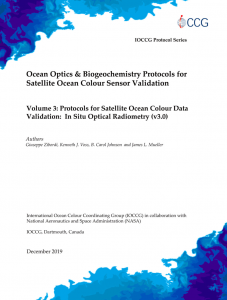 This protocol document aims to support the ocean color community with protocols for the collection, processing and quality assurance of in situ measurements of the apparent optical properties of natural water for the validation of satellite radiometric products. In addition to a general introduction on Elements of Marine Optical Radiometry Data and Analysis (Chapter 1), the document addresses Radiometers Specifications (Chapter 2), Calibration and Characterization of Optical Radiometers (Chapter 3), In-water Radiometry Measurements and Data Analysis (Chapter 4), and Above-water Radiometry Measurements and Data Analysis (Chapter 5).
This protocol document aims to support the ocean color community with protocols for the collection, processing and quality assurance of in situ measurements of the apparent optical properties of natural water for the validation of satellite radiometric products. In addition to a general introduction on Elements of Marine Optical Radiometry Data and Analysis (Chapter 1), the document addresses Radiometers Specifications (Chapter 2), Calibration and Characterization of Optical Radiometers (Chapter 3), In-water Radiometry Measurements and Data Analysis (Chapter 4), and Above-water Radiometry Measurements and Data Analysis (Chapter 5).
The overall structure and content of the various chapters are based on, and benefit from, the Ocean Optics Protocols promoted by the National Aeronautics and Space Administration within the framework of the Sea-Viewing Wide Field-of-View Sensor (SeaWiFS) and Sensor Intercomparison for Marine Biological and Interdisciplinary Ocean Studies (SIMBIOS) programs (Mueller and Austin 1995, Mueller et al. 2003a, Mueller et al. 2003b).
It is emphasized that, by recognizing optical radiometry can be heavily affected by the presence of clouds which will unavoidably challenge the quantification of measurement uncertainties, the protocols put emphasis only on measurements performed during clear sky conditions, which are those relevant for the validation of satellite ocean color data products.
Finally, it is anticipated that the chapters on in-water and above-water radiometry provide comprehensive details on those measurement methods sharing large consensus inside the community and whose application is strongly encouraged. Conversely, brief summaries are only provided for those methods already well represented by the previous ones or for those methods that may exhibit difficult implementation in a variety of measurement conditions.
Correct citation for this volume:
IOCCG Protocol Series (2019). Inherent Optical Property Measurements and Protocols: Best Practices for the Collection and Processing of Ship-Based Underway Flow-Through Optical Data. Boss, E., Haëntjens, N., Ackleson, S., Balch, B., Chase, A., Dall’Olmo, G., Freeman, S., Liu, Y., Loftin, J., Neary, W., Nelson, N., Novak, M., Slade, W., Proctor, C., Tortell, P., and Westberry. T. IOCCG Ocean Optics and Biogeochemistry Protocols for Satellite Ocean Colour Sensor Validation, Volume 4.0, edited by A. R. Neeley and A. Mannino, IOCCG, Dartmouth, NS, Canada. http://dx.doi.org/10.25607/OBP-664
Download file: Inherent Optical Property Measurements and Protocols: Best Practices for the Collection and Processing of Ship-Based Underway Flow-Through Optical Data (November 2019)
Abstract
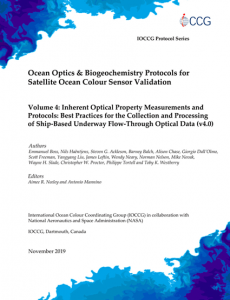 Optical data can be collected using the flow-through systems installed on research vessels and ships of opportunity to take advantage of the availability of sea water pumped into the vessel. These “in-line” or “underway” systems are able to provide data at spatial resolutions on the order of 10-100 m. As the number of research groups making these measurements grows, there is a need to provide coordinated data collection and processing protocols to standardize methodology and data quality. In 2015, a NASA-sponsored workshop was organized to share such knowledge. Here, we discuss the essential issues associated with in-line data collection, provide recommendations on best practices for collection and processing and report on available software.
Optical data can be collected using the flow-through systems installed on research vessels and ships of opportunity to take advantage of the availability of sea water pumped into the vessel. These “in-line” or “underway” systems are able to provide data at spatial resolutions on the order of 10-100 m. As the number of research groups making these measurements grows, there is a need to provide coordinated data collection and processing protocols to standardize methodology and data quality. In 2015, a NASA-sponsored workshop was organized to share such knowledge. Here, we discuss the essential issues associated with in-line data collection, provide recommendations on best practices for collection and processing and report on available software.
A draft version of the protocol entitled “Measurement Protocol of Absorption by Chromophoric Dissolved Organic Matter (CDOM) and Other Dissolved Materials“, is available.
Summary: Measuring light absorption by CDOM in situ is necessary for developing and validating current and future ocean color algorithms. A CDOM Working Group has revised this section of the NASA ocean optics protocols (Mitchell et al. 2003) under the auspices of the IOCCG to reflect the development of new instrumentation and a greater understanding of the importance of CDOM and its distribution in coastal and open ocean waters over the past twenty years. Our goal here is to describe a set of procedures that will be adhered to by the scientific community for making CDOM absorption measurements that can be integrated into bio-optical databases, specifically of sufficient quality to develop and validate ocean color algorithms/products and contribute to CDOM science. The deadline for community feedback closed in late December 2019. The draft version will be revised according to review comments received and will be posted on this site in the near future.
Download Protocol: Measurement Protocol of Absorption by Chromophoric Dissolved Organic Matter (CDOM) and Other Dissolved Materials (DRAFT)
Correct citation for this volume:
IOCCG Protocol Series (2021). Particulate Organic Matter Sampling and Measurement Protocols: Consensus Towards Future Ocean Color Missions. Chaves, J.E., Cetinić, I., Dall’Olmo, G., Estapa, M., Gardner, W., Goñi, M., Graff, J.R., Hernes, P., Lam, P.J., Liu, Z., Lomas, M.W., Mannino, M., Novak, M.G., Turnewitsch, R., Werdell, P.J., Westberry, T.K., IOCCG Ocean Optics and Biogeochemistry Protocols for Satellite Ocean Colour Sensor Validation, Volume 6.0, IOCCG, Dartmouth, NS, Canada. http://dx.doi.org/10.25607/OBP-1646
Download file: Particulate Organic Matter Sampling and Measurement Protocols: Consensus Towards Future Ocean Color Missions. (August 2021)
Summary
 This document is the product of a multi-year effort that started with a two-and-a-half-day workshop organized by the NASA Ocean Ecology Lab Field Support Group and hosted at NASA Goddard Space Flight Center from November 30–December 2, 2016. The original objective was to produce community consensus protocols for sample collection, filtration, storage, analysis, and quality assurance for particulate organic carbon in all natural waters, emphasizing marine ecosystems, appropriate for satellite algorithm development and validation. Given the close link between global cycles of carbon and nitrogen and that current analytical protocols usually are geared towards their simultaneous measurement, recommendations for analysis of nitrogen in particles are also included. The hope is that the protocols presented here can be widely adopted by the academic scientific community engaged in aquatic C and N cycle research, particularly in activities that support ocean color validation. The resulting protocol review document: Particulate Organic Matter Sampling and Measurement Protocols: Consensus Towards Future Ocean Color Missions, and the associated workshop activity were sponsored by the National Aeronautics and Space Administration (NASA), including funding for the Field Support Group (NASA Ocean Biology and Biogeochemistry Program) and a ROSES NNH15ZDA001N-TWSC award to Antonio Mannino, Ivona Cetinić, Joaquín Chaves, Michael Novak, and Jeremy Werdell under the NASA Program Topical Workshops, Symposia, and Conferences Program with additional support for contributing authors and workshop participants by their respective institutions. This document provides a detailed discussion of state-of-the-art technologies and protocols for sampling and measuring aquatic particulate organic carbon and particulate nitrogen. Appendix A provides a summary of best practices and recommendations for those developing a research program that includes measurements of POM. Significant contributions by all authors and reviewers made the completion of this document possible. Reference herein to any specific commercial products, processes, or services by trade name, trademark, manufacturer, or otherwise does not constitute or imply its endorsement or recommendation by the authors or their employers.
This document is the product of a multi-year effort that started with a two-and-a-half-day workshop organized by the NASA Ocean Ecology Lab Field Support Group and hosted at NASA Goddard Space Flight Center from November 30–December 2, 2016. The original objective was to produce community consensus protocols for sample collection, filtration, storage, analysis, and quality assurance for particulate organic carbon in all natural waters, emphasizing marine ecosystems, appropriate for satellite algorithm development and validation. Given the close link between global cycles of carbon and nitrogen and that current analytical protocols usually are geared towards their simultaneous measurement, recommendations for analysis of nitrogen in particles are also included. The hope is that the protocols presented here can be widely adopted by the academic scientific community engaged in aquatic C and N cycle research, particularly in activities that support ocean color validation. The resulting protocol review document: Particulate Organic Matter Sampling and Measurement Protocols: Consensus Towards Future Ocean Color Missions, and the associated workshop activity were sponsored by the National Aeronautics and Space Administration (NASA), including funding for the Field Support Group (NASA Ocean Biology and Biogeochemistry Program) and a ROSES NNH15ZDA001N-TWSC award to Antonio Mannino, Ivona Cetinić, Joaquín Chaves, Michael Novak, and Jeremy Werdell under the NASA Program Topical Workshops, Symposia, and Conferences Program with additional support for contributing authors and workshop participants by their respective institutions. This document provides a detailed discussion of state-of-the-art technologies and protocols for sampling and measuring aquatic particulate organic carbon and particulate nitrogen. Appendix A provides a summary of best practices and recommendations for those developing a research program that includes measurements of POM. Significant contributions by all authors and reviewers made the completion of this document possible. Reference herein to any specific commercial products, processes, or services by trade name, trademark, manufacturer, or otherwise does not constitute or imply its endorsement or recommendation by the authors or their employers.
Correct citation for this volume:
IOCCG Protocol Series (2022). Aquatic Primary Productivity Field Protocols for Satellite Validation and Model Synthesis. Balch, W.M., Carranza, M., Cetinić, I., Chaves, J.E., Duhamel, S., Fassbender, A., Fernandez-Carrera, A., Ferrón, S., García-Martín, E., Goes, J., Gomes, H., Gundersen, K., Halsey, K., Hirawake, T., Isada, T., Juranek, L., Kulk, G., Langdon, C., Letelier, R., López-Sandoval, D., Mannino, A., Marra, J.F., Neale, P., Nicholson, D., Silsbe, G., Stanley, R.H., Vandermeulen, R.A. IOCCG Ocean Optics and Biogeochemistry Protocols for Satellite Ocean Colour Sensor Validation, Volume 7.0, edited by R.A. Vandermeulen, J. E. Chaves, IOCCG, Dartmouth, NS, Canada. http://dx.doi.org/10.25607/OBP-1835
Download file: Aquatic Primary Productivity Field Protocols for Satellite Validation and Model Synthesis (September 2022).
Supporting information for Ch 3: Download Excel file
Abstract
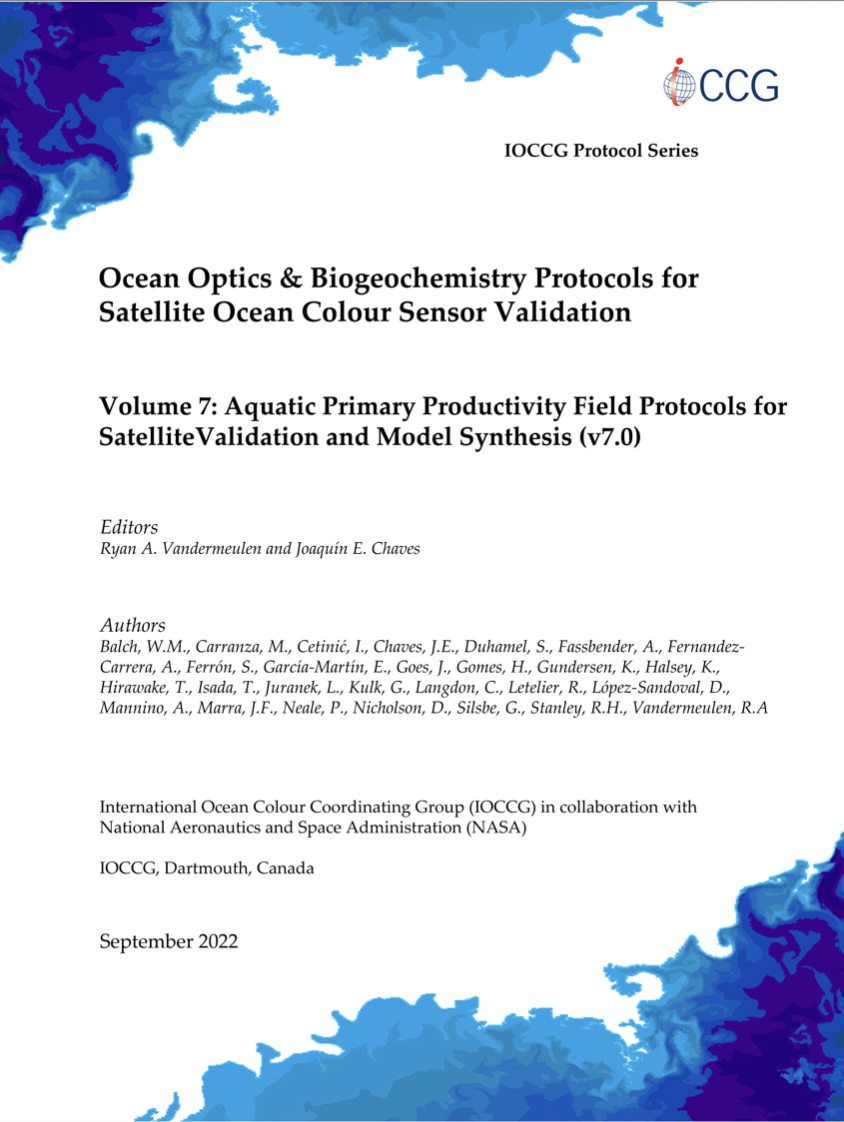 The measurement of aquatic primary productivity (PP) is central to the quantitative understanding of the global biosphere, yielding critical insights into the role and magnitude of carbon, oxygen, and other bioactive element fluxes between the ocean, the geosphere, and the atmosphere. The accumulation of theoretical, methodological, and technological advances has led to the development of numerous approaches to measure oceanic PP, all with the common objective of quantifying the fluxes of reduced carbon into aquatic ecosystems. Methods to derive estimates of PP include, the analysis of incubations to measure dissolved oxygen gas accumulation and consumption, radioactive 14C, stable 13C, and 18O uptake, isotopic composition of atmospheric and dissolved oxygen, underway measurements of O2/Ar, kinetic measurements of variable chlorophyll fluorescence, and temporally and spatially integrated time series from gliders or buoys. Integrating these measurements with satellite observations of ocean biomass and its physical environment enable the scaling up of PP data into a comprehensive, global picture. The main goal for these PP protocols is to establish a set of best practices across multiple methods for measuring aquatic primary productivity, in an effort to constrain systematic and random measurement biases. Through a better understanding of the different capabilities, assumptions, and limitations inherent to each measurement, users may leverage the assets and liabilities of each method in the context of satellite validation and model synthesis.
The measurement of aquatic primary productivity (PP) is central to the quantitative understanding of the global biosphere, yielding critical insights into the role and magnitude of carbon, oxygen, and other bioactive element fluxes between the ocean, the geosphere, and the atmosphere. The accumulation of theoretical, methodological, and technological advances has led to the development of numerous approaches to measure oceanic PP, all with the common objective of quantifying the fluxes of reduced carbon into aquatic ecosystems. Methods to derive estimates of PP include, the analysis of incubations to measure dissolved oxygen gas accumulation and consumption, radioactive 14C, stable 13C, and 18O uptake, isotopic composition of atmospheric and dissolved oxygen, underway measurements of O2/Ar, kinetic measurements of variable chlorophyll fluorescence, and temporally and spatially integrated time series from gliders or buoys. Integrating these measurements with satellite observations of ocean biomass and its physical environment enable the scaling up of PP data into a comprehensive, global picture. The main goal for these PP protocols is to establish a set of best practices across multiple methods for measuring aquatic primary productivity, in an effort to constrain systematic and random measurement biases. Through a better understanding of the different capabilities, assumptions, and limitations inherent to each measurement, users may leverage the assets and liabilities of each method in the context of satellite validation and model synthesis.
A draft version of the protocol entitled “Dissolved Organic Matter Sampling and Measurement Protocols: Consensus Towards Future Ocean Color Missions“, is currently in revision after community comment and peer review.
Summary: This community protocol document on dissolved organic carbon measurements aims to integrate the latest advances in sampling, instrument measurement, and data analysis to provide reliable DOC values and uncertainties to support ocean colour satellite algorithm development and validation, as well as carbon cycle studies for inland, coastal, and ocean waters.
Download Draft Protocol: Dissolved Organic Matter Sampling and Measurement Protocols: Consensus Towards Future Ocean Color Missions (MS Word)
Noteworthy and Supplemental Topics on Ocean Colour Radiometry Protocols
This section contains stand-alone chapters on practical protocols, including measurements in sub-optimal conditions. New chapters may be added periodically, and will explain how to deploy radiometers and process data under various sky and sea states, and in a wide range of water types and bathymetry, including state-of-the-art techniques and instruments.
- Skylight-Blocked Approach and Data Processing Scheme directly measures Lw for the calculation of remote sensing reflectance (Rrs). Download Chapter: On-Water Radiometry Measurements: Skylight-Blocked Approach and Data Processing (Draft)
Public comment and review for this chapter is closed and the chapter is under review by the Editorial Review Board.
Other Community Protocols for Satellite Ocean Colour Validation
Description of measurement methods used both in field and in laboratory by the GLaSS community. It describes used instrumentation and parameters gathered for calibration/validation activities as a background for remote sensing of lakes. It also describes major differences from NASA Ocean Colour protocols, which are generally used as guidelines for in situ measurements for remote sensing purposes and gives an overview of the sources of variation of in situ data. This document is a start of the development of dedicated protocols for optical measurements and satellite validation for inland waters of different types.
Ruddick, K. G., K. Voss, E. Boss, A. Castagna, R. Frouin, A. Gilerson, M. Hieronymi, B. C. Johnson, J. Kuusk, Z. Lee, M. Ondrusek, V. Vabson, and R. Vendt, 2019: A review of protocols for fiducial reference measurements of water-leaving radiance for validation of satellite remote sensing data over water, Remote Sensing, 11, 1742 https://doi.org/10.3390/rs11151742
Ruddick, K. G., K. Voss, A. C. Banks, E. Boss, A. Castagna, R. Frouin, M. Hieronymi, C. Jamet, B. C. Johnson, J. Kuusk, Z. Lee, M. Ondrusek, V. Vabson, and R. Vendt, 2019: A review of protocols for Fiducial reference measurements for downwelling irradiance for validation of satellite remote sensing data over water, Remote Sensing, 11, 2198, https://doi.org/10.3390/

 The sixth International Ocean Colour Science (IOCS) meeting will take place in Darmstadt, Germany from 1 – 4 December 2025, hosted by EUMETSAT and ESA with support from other agencies.
The sixth International Ocean Colour Science (IOCS) meeting will take place in Darmstadt, Germany from 1 – 4 December 2025, hosted by EUMETSAT and ESA with support from other agencies.